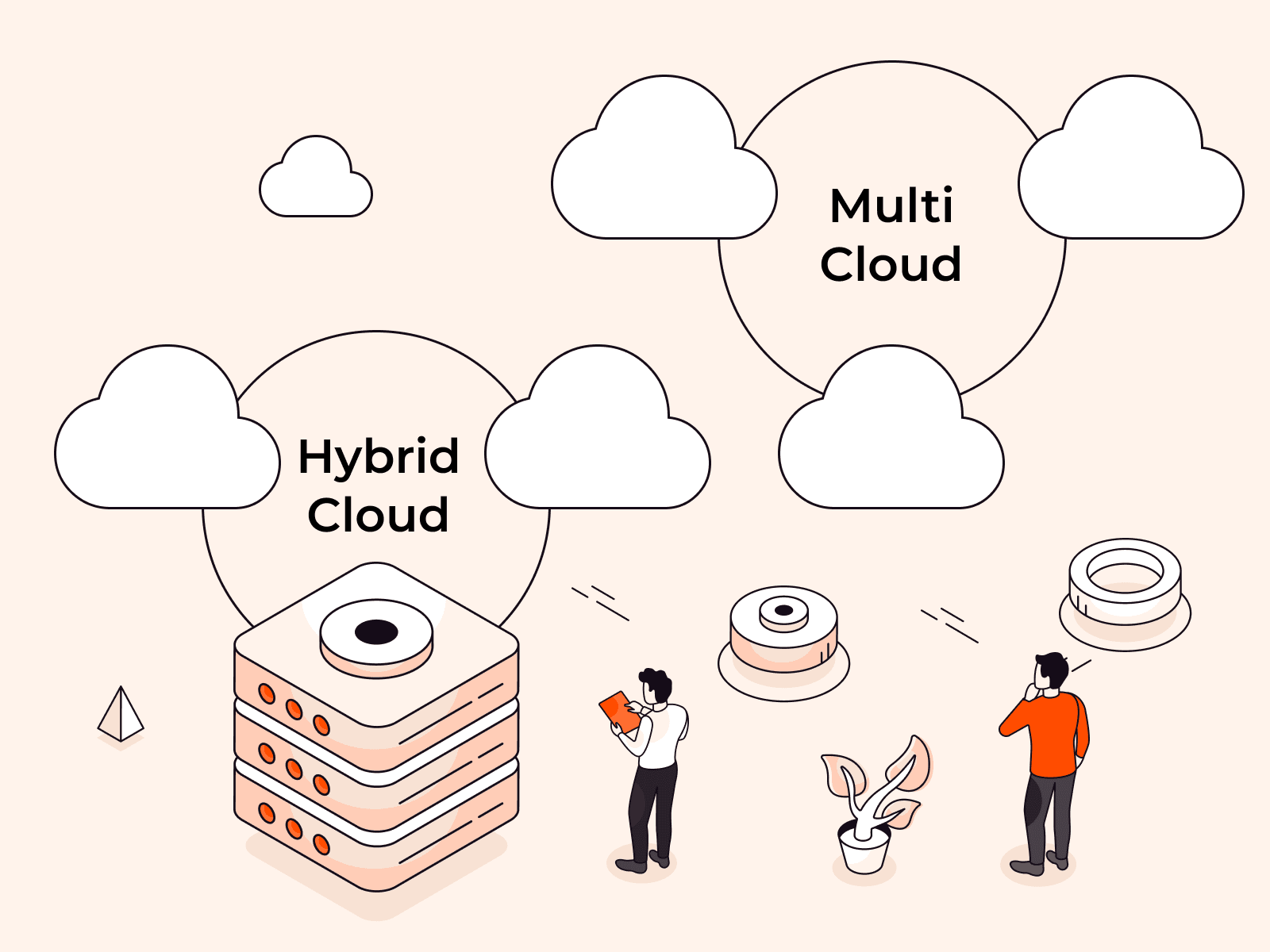Multi-cloud is a cloud usage model where an organization utilizes public cloud services from two or more cloud service providers, often combining public, private, and hybrid clouds, as well as different service models, such as Infrastructure as a Service (IaaS), Platform as a Service (PaaS), and Software as a Service (SaaS). According to the 2024 State of the Cloud Report by Flexera, 92% of enterprises now use multiple cloud services.
Multi-cloud architecture works by distributing applications and data across multiple cloud providers, using each provider's strengths and geographic locations to improve performance, cost, and compliance. This approach enables workload, data, traffic, and workflow portability across different cloud platforms, creating enhanced flexibility and resilience for organizations.
Multi-cloud environments can reduce latency by up to 30% through geographical distribution of processing requests to physically closer cloud units.
The main types of multi-cloud deployments include hybrid cloud with multi-cloud services and workload-specific multi-cloud configurations. In hybrid multi-cloud setups, sensitive data remains on private clouds, while flexible workloads run across multiple public clouds. Workload-specific multi-cloud matches different applications to the cloud provider best suited for their specific requirements and performance needs.
Multi-cloud offers several key benefits that drive enterprise adoption across industries.
Over 80% of enterprises report improved disaster recovery capabilities with multi-cloud strategies, as organizations can distribute their infrastructure across multiple providers to avoid single points of failure. This approach also provides cost optimization opportunities, vendor independence, and access to specialized services from different providers.
Understanding multi-cloud architecture is important because it represents the dominant cloud plan for modern enterprises seeking to balance performance, cost, security, and compliance requirements. Organizations that master multi-cloud use gain competitive advantages through increased flexibility, improved disaster recovery, and the ability to choose the best services from each provider.
What is multi-cloud?
Multi-cloud is a planned approach to cloud use where organizations utilize services from two or more cloud providers simultaneously. Creating an integrated environment that combines public, private, and hybrid clouds, along with different service models like IaaS. PaaS and SaaS. This architecture enables workload and data portability across different platforms, allowing businesses to distribute applications based on each provider's strengths, geographic locations, and specific capabilities. According to Flexera (2024), 92% of enterprises now use multiple cloud services, reflecting the growing adoption of this integrated approach. Multi-cloud differs from simply using multiple isolated cloud environments by focusing on unified management and planned distribution rather than maintaining separate, disconnected cloud silos.
How does multi-cloud architecture work?
Multi-cloud architecture works by distributing applications, data, and workloads across multiple cloud service providers to create an integrated computing environment. Organizations connect and manage services from different cloud platforms through centralized orchestration tools and APIs, treating the diverse infrastructure as a unified system rather than separate silos. The architecture operates through several key mechanisms.
First, workload distribution allows companies to place specific applications on the cloud platform best suited for each task. Compute-intensive processes might run on one provider while data analytics runs on another. Second, data replication and synchronization tools keep information consistent across platforms, enabling failover and backup capabilities.
Third, network connectivity solutions, such as VPNs and dedicated connections, securely link the different cloud environments. Management is facilitated through cloud orchestration platforms that provide a single control plane for monitoring, utilizing, and scaling resources across all connected providers. These tools consistently handle authentication, resource allocation, and policy enforcement, regardless of the underlying cloud platform.
Load balancers and traffic management systems automatically route user requests to the most suitable cloud location, based on factors such as geographic proximity, current capacity, and performance requirements. This distributed approach enables organizations to avoid vendor lock-in while improving costs through competitive pricing negotiations.
It also improves disaster recovery by spreading risk across multiple platforms and helps meet regulatory compliance requirements by placing data in specific geographic regions as needed.
What are the types of multi-cloud deployments?
Types of multi-cloud deployments refer to the different architectural approaches organizations use to distribute workloads and services across multiple cloud providers. The types of multi-cloud deployments are listed below.
- Hybrid multi-cloud: This approach combines private cloud infrastructure with services from multiple public cloud providers. Organizations store sensitive data and critical applications on private clouds, while utilizing different public clouds for specific workloads, such as development, testing, or seasonal growth.
- Workload-specific multi-cloud: Different applications and workloads are matched to the cloud provider that best serves their specific requirements. For example, compute-intensive tasks may run on one provider, while machine learning workloads utilize another provider's specialized AI services.
- Geographic multi-cloud: Services are distributed across multiple cloud providers based on geographic regions to meet data sovereignty requirements and reduce latency. This use ensures compliance with local regulations while improving performance for users in different locations.
- Disaster recovery multi-cloud: Primary workloads run on one cloud provider while backup systems and disaster recovery infrastructure operate on different providers. This approach creates redundancy and ensures business continuity in the event that one provider experiences outages.
- Cost-optimized multi-cloud: Organizations carefully place workloads across different providers based on pricing models and cost structures. This usage type enables companies to benefit from competitive pricing and avoid vendor lock-in situations.
- Compliance-driven multi-cloud: Different cloud providers are used to meet specific regulatory and compliance requirements across various jurisdictions. Financial services and healthcare organizations often use this approach to satisfy industry-specific regulations while maintaining operational flexibility.
What are the benefits of multi-cloud?
The benefits of multi-cloud refer to the advantages organizations gain from using cloud services across multiple providers in an integrated approach. The benefits of multi-cloud are listed below.
- Vendor independence: Multi-cloud prevents organizations from becoming locked into a single provider's ecosystem and pricing structure. Companies can switch between providers or negotiate better terms when they're not dependent on one vendor.
- Cost optimization: Organizations can choose the most cost-effective provider for each specific workload or service type. This approach allows companies to negotiate up to 20% better pricing by using competition among providers.
- Improved disaster recovery: Distributing workloads across multiple cloud providers creates natural redundancy and backup options. Over 80% of enterprises report improved disaster recovery capabilities with multi-cloud strategies in place.
- Regulatory compliance: Multi-cloud enables organizations to meet data sovereignty requirements by storing data in specific geographic regions. Financial and healthcare companies can comply with local regulations while maintaining global operations.
- Performance optimization: Different providers excel in different services, allowing organizations to match workloads with the best-suited platform. Multi-cloud environments can reduce latency by up to 30% through geographic distribution of processing requests.
- Risk mitigation: Spreading operations across multiple providers reduces the impact of service outages or security incidents. If one provider experiences downtime, critical operations can continue on alternative platforms.
- Access to specialized services: Each cloud provider offers unique tools and capabilities that may not be available elsewhere. Organizations can combine the best machine learning tools from one provider with superior storage solutions from another.
What are the challenges of multi-cloud?
Challenges of multi-cloud refer to the difficulties and obstacles organizations face when managing and operating cloud services across multiple cloud providers. The challenges of multi-cloud are listed below.
- Increased complexity: Managing multiple cloud environments creates operational overhead that can overwhelm IT teams, leading to inefficiencies and increased costs. Each provider has different interfaces, APIs, and management tools that require specialized knowledge and training.
- Security management: Maintaining consistent cloud security policies across different cloud platforms becomes exponentially more difficult. Organizations must monitor and secure multiple attack surfaces while ensuring compliance standards are met across all environments.
- Cost visibility: Tracking and controlling expenses across multiple cloud providers creates billing complexity that's hard to manage. Without proper monitoring tools, organizations often face unexpected costs and struggle to improve spending across platforms.
- Data combination: Moving and synchronizing data between different cloud environments introduces latency and compatibility issues. Organizations must also handle varying data formats and transfer protocols between different providers.
- Skill requirements: Multi-cloud environments demand expertise in multiple platforms, creating significant training costs and talent acquisition challenges. IT teams need to master different cloud architectures, tools, and best practices simultaneously.
- Vendor management: Coordinating with multiple cloud providers for support, updates, and service-level agreements creates an administrative burden. Organizations must maintain separate relationships and contracts while ensuring consistent service quality.
- Network connectivity: Establishing reliable, high-performance connections between different cloud environments requires careful planning and often expensive dedicated links. Latency and bandwidth limitations can impact application performance across distributed workloads.
How to implement a multi-cloud strategy
You use a multi-cloud plan by selecting multiple cloud providers, designing an integrated architecture, and establishing unified management processes across all platforms.
- First, assess your organization's specific needs and define clear objectives for multi-cloud adoption. Identify which workloads require high availability, which need cost optimization, and which must comply with data sovereignty requirements. Document your current infrastructure, performance requirements, and budget constraints to guide provider selection.
- Next, select 2-3 cloud providers based on their strengths for different use cases. Choose providers that excel in areas matching your workload requirements - one might offer superior compute services while another provides better data analytics tools. Avoid selecting too many providers initially, as this increases management complexity.
- Then, design your multi-cloud architecture with clear workload distribution rules. Map specific applications and data types to the most suitable cloud platforms based on performance, compliance, and cost factors. Plan for data synchronization and communication pathways between different cloud environments.
- After that, establish unified identity and access management across all selected platforms. Set up single sign-on solutions and consistent security policies to maintain control while enabling cooperative user access. This prevents security gaps that often emerge when managing multiple separate cloud accounts.
- Use centralized monitoring and management tools that provide visibility across all cloud environments. Use cloud management platforms or multi-cloud orchestration tools that can track performance, costs, and security metrics from a single dashboard.
- Create standardized use processes and automation workflows that work consistently across different cloud platforms. Utilize infrastructure-as-code tools and containerization to ensure that applications can be deployed and managed uniformly, regardless of the underlying cloud provider.
- Finally, establish clear governance policies for data placement, workload migration, and cost management. Define which types of data can be stored where, set up automated cost alerts, and create procedures for moving workloads between clouds when needed. Start with a pilot project using two providers before expanding to additional platforms - this allows you to refine your processes and identify potential combination challenges early.
What is the difference between multi-cloud and hybrid cloud?
Multi-cloud differs from hybrid cloud primarily in provider diversity, infrastructure composition, and management scope. Multi-cloud utilizes services from multiple public cloud providers to avoid vendor lock-in and optimize specific workloads, while hybrid cloud combines public and private cloud infrastructure to strike a balance between security, control, and flexibility within a unified environment. Infrastructure architecture distinguishes these approaches.
Multi-cloud distributes workloads across different public cloud platforms, with each provider handling specific applications based on their strengths. One might excel at machine learning, while another offers better database services. Hybrid cloud integrates on-premises private infrastructure with public cloud resources, creating a bridge between internal systems and external cloud capabilities that organizations can control directly.
Management complexity varies considerably between the two models. Multi-cloud requires coordinating multiple vendor relationships, different APIs, security protocols, and billing systems across various platforms. Hybrid cloud focuses on managing the connection and data flow between private and public environments, typically involving fewer vendors but requiring more advanced combinations between on-premises and cloud infrastructure. Cost and compliance considerations also differ substantially.
Multi-cloud enables organizations to negotiate better pricing by playing providers against each other and selecting the most cost-effective service for each workload, according to Flexera (2024), with 92% of enterprises now using multiple cloud services. Hybrid cloud prioritizes data sovereignty and regulatory compliance by keeping sensitive information on private infrastructure.
Public clouds are particularly valuable for less critical workloads in industries with strict data governance requirements.
What are multi-cloud best practices?
Multi-cloud best practices refer to proven methods and strategies for effectively managing and operating workloads across multiple cloud service providers. The multi-cloud best practices are listed below.
- Develop a clear multi-cloud plan: Define specific business objectives for using multiple cloud providers before use. This plan should identify which workloads belong on which platforms and establish clear criteria for cloud selection based on performance, cost, and compliance requirements.
- Establish consistent security policies: Create unified security frameworks that work across all cloud environments to maintain consistent protection across all environments. This includes standardized identity and access management, encryption protocols, and security monitoring that spans multiple platforms.
- Utilize cloud-agnostic tools: Select management and monitoring tools that can operate across various cloud platforms to minimize complexity. These tools help maintain visibility and control over resources regardless of which provider hosts them.
- Plan for data governance: Use precise data classification and management policies that address where different types of data can be stored. This includes considering data sovereignty requirements and ensuring compliance with regulations across all cloud environments.
- Design for portability: Build applications and configure workloads so they can move between cloud providers when needed. This approach prevents vendor lock-in and maintains flexibility for future changes in cloud plan.
- Monitor costs across platforms: Track spending and resource usage across all cloud providers to identify optimization opportunities. Regular cost analysis helps ensure the multi-cloud approach delivers the expected financial benefits.
- Establish disaster recovery procedures: Create backup and recovery plans that work across multiple cloud environments to improve resilience. This includes testing failover procedures and ensuring that data can be recovered from any provider in the event of outages.
How does Gcore support multi-cloud strategies?
When building multi-cloud strategies, the success of your approach depends heavily on having infrastructure partners that can bridge different cloud environments while maintaining consistent performance. Gcore's global infrastructure supports multi-cloud deployments with over 210 points of presence worldwide, delivering an average latency of 30ms that helps reduce the geographic performance gaps that often challenge multi-cloud architectures.
Our edge cloud services and CDN services work across your existing cloud providers, creating a unified connectivity layer that multi-cloud environments need, while avoiding the vendor lock-in concerns that drive organizations toward multi-cloud strategies in the first place.
This approach typically reduces the operational complexity that causes 40% increases in management overhead, while maintaining the flexibility to distribute workloads based on each provider's strengths. Discover how Gcore's infrastructure can support your multi-cloud strategy at gcore.com.
Frequently asked questions
What is an example of multi-cloud?
An example of multi-cloud is a company using cloud services from multiple providers, such as running databases on one platform, web applications on another, and data analytics on a third provider, while managing them as one integrated system. This differs from simply having separate accounts with different providers by creating unified management and workload distribution across platforms.
How many cloud providers do I need for multi-cloud?
Most organizations need 2-3 cloud providers for effective multi-cloud use. This typically includes one primary provider for core workloads and one to two secondary providers for specific services, disaster recovery, or compliance requirements.
Can small businesses use multi-cloud?
Yes, small businesses can utilize a multi-cloud approach by starting with two cloud providers for specific workloads, such as backup and primary operations. This approach helps them avoid vendor lock-in and improve disaster recovery without the complexity of managing many platforms at once.
What is the difference between multi-cloud and multitenancy?
Multi-cloud utilizes multiple cloud providers for various services, whereas multitenancy enables multiple customers to share the same cloud infrastructure. Multi-cloud is about distributing workloads across different cloud platforms for flexibility and avoiding vendor lock-in. In contrast, multitenancy involves sharing resources, where a single provider serves multiple isolated customer environments on shared hardware.
Which industries benefit most from multi-cloud?
Financial services, healthcare, retail, and manufacturing industries benefit most from multi-cloud strategies due to their strict compliance requirements and diverse workload needs. These sectors use multi-cloud to meet data sovereignty laws, improve disaster recovery, and reduce costs across different cloud providers' specialized services.
Can I use Kubernetes for multi-cloud?
Yes. Kubernetes supports multi-cloud deployments through its cloud-agnostic architecture and standardized APIs that work across different cloud providers. You can run Kubernetes clusters on multiple clouds simultaneously, distribute workloads based on specific requirements, and maintain consistent application use patterns regardless of the underlying infrastructure. Read more about Gcore’s Managed Kubernetes service here.
Related articles
Subscribe to our newsletter
Get the latest industry trends, exclusive insights, and Gcore updates delivered straight to your inbox.






